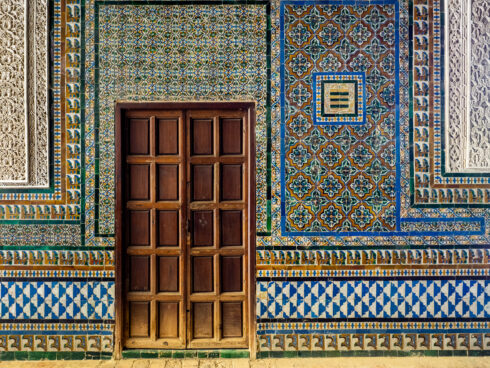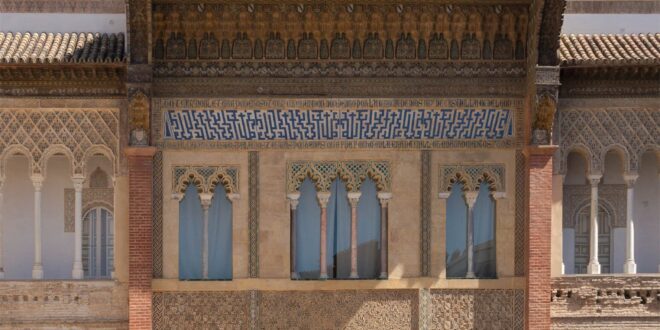MUDEJAR, a style unique to medieval Spain, is a beautiful reminder of Spain’s rich culture.
During the Christian Reconquista when Muslim artisans continued to work on conquered Catholic territory, this style was influenced by Islamic design principles.
The result is an enchanting fusion of Islamic aesthetics with Christian functionality. It’s characterized by intricate stucco work, stunning brick construction, and ornate tilework.
Several remarkable examples of Mudejar-style architecture still exist in Spain today. Each one tells a tale of artistic creativity and coexistence.
READ MORE
The best surviving examples – from the majestic Aljaferia Palace to the intricate details of the Church of San Bartolome – invite us to explore the beauty of this unique architectural style.
Mudejar is found in both the palaces and churches of Andalucia. It represents resilience, creativity and a spirit of tolerance that endures.
Here are some of our favorite examples:
The Aljaferia Palace in Zaragoza

The Aljaferia Palace, built in Zaragoza in the 11th Century as a residence of Muslim rulers, is one of the most famous examples of Mudejar architectural style.
It is now a UNESCO World Heritage Site, showcasing the intricate craftsmanship of that era. Horseshoe arches and intricate plasterwork are featured, as well as beautifully tiled walls.
The patio of the palace is a stunning example of Mudejar architecture. It features a series arches, and vibrant azulejos. The palace was converted by the Catholic monarchs after its reconquest. However, it still retained its Islamic architectural features, which symbolises the blending cultures that defines the style.
The Cathedral of Toledo

In Toledo, the Cathedral of Saint Mary is a stunning example of Mudejar influences being integrated into Gothic Architecture. The cathedral is predominantly Gothic, but its Mudejar-style tower from the 12th century is an outstanding feature.

The tower’s brick façade and intricate tilework showcase the decorative richness typical of Mudejar craftsmanship.
The beautifully crafted wooden ceilings show the skills and artistry that Moorish craftsmen possessed.
The harmonious mix of styles in the cathedral is a testimony to cultural exchanges which shaped Spain’s architecture heritage.
The Church of San Bartolome Sevilla

Sevilla’s Church of San Bartolome is another stunning example of Mudejar-style architecture.
This church, built in the 14th Century, is a perfect example of the Mudejar style.
The Torre de San Bartolome bell tower features decorative brickwork patterns and tiles, which showcase the artistry from the period.
The interior of this church is equally beautiful, with wooden ceilings that are influenced by Islamic influence and beautiful altarpieces.

The church is not only a place of worship, but it also serves as a museum that showcases the artistic traditions of Andalucia.
The Palacio de Gaudi, Astorga

The Palacio Gaudi is a fascinating look at the Mudejar revival of the 19th century.
The palace is primarily known as a Neo-Gothic building, but it also incorporates Mudejar features, especially in the tilework and decorative elements.
The building’s façade, with its striking spires and intricate brick patterns, pays homage to the historical style while embracing modern techniques.

Gaudi’s interpretation of Mudejar is a bridge that connects the past with the present. It illustrates the lasting influence of this architectural style in contemporary design.
The Church of San Tirso (Sahagun)

In the province of Leon you will find the Church of San Tirso. It is a beautiful example of Mudejar Romanesque architectural style.
The church dates back to the 12th Century and is almost entirely made of bricks, which is a characteristic of the Mudejar style.

Horseshoe arches are a common sight, as well as blind arcades and brick patterns that show the influence of both Islamic and Christian cultures in northern Spain.
Alcazar in Sevilla

The Alcazar in Sevilla, one of the most famous Mudejar Palaces in Spain was originally a Muslim Fortress. It was then expanded by Christian rulers.

Palacio del Rey Don Pedro is a stunning example of Mudejar style architecture. It features intricate stucco decoration, geometric tiles and wooden ceilings.
It is still one of Europe’s best preserved royal palaces and a testament of Mudejar culture.
The Church of San Martin Teruel

The Church of San Martin was built in Teruel’s Mudejar-style heritage city, Teruel.
Its bell-tower, which is decorated in geometric brickwork and ceramic glazed glaze, is a masterpiece Aragonese Mudejar.
The tower and other Mudejar landmarks of Teruel are recognized by UNESCO as a World Heritage Site.
The Casa de Pilatos, Sevilla

Casa de Pilatos is a palace from the 16th century in Sevilla that blends Italian Renaissance with Mudejar style.
Mudejar architecture is evident in the courtyards, wooden floors, and ceramic tiles.

The mudejar style is evident in the horseshoe arches, stuccowork and other details.
The Tower of El Salvador Teruel

In the 14th Century, the Tower of El Salvador was constructed. This is yet another gem of Teruel’s Mudejar legacy.
This tower is one of the most impressive Mudejar buildings in Spain. It features intricate brick patterns, ceramic inlays and a stunning design.
The tower’s climb offers a breathtaking view of Teruel, a city that is often overlooked yet rich in architectural treasures.
 Costa News Spain Breaking News | English News in Spain.
Costa News Spain Breaking News | English News in Spain.





